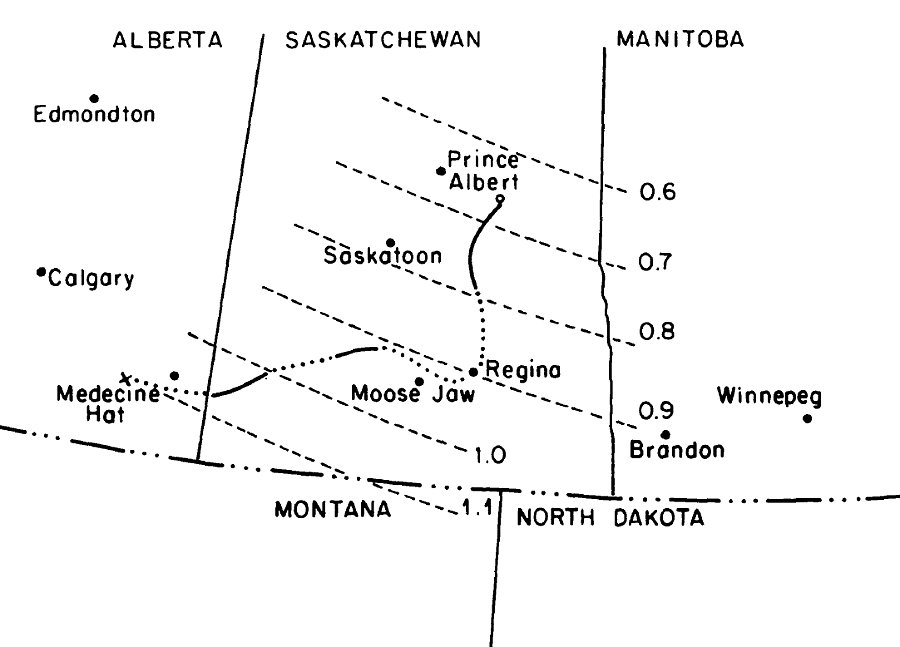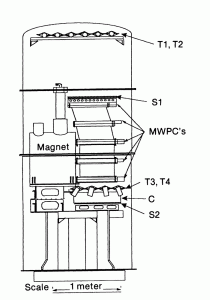Purpose of the flight and payload description
The instrument design -as many others of those years- was an adaptation of the basic configuration of the so called Balloon-Borne Magnet Facility (BBMF), a payload developed by New Mexico State University and NASA's Goddard Space Flight Center to perform research on high energy particles using a magnet spectrometer.
The instrument flown on this mission is illustrated in the figure at left (click to enlarge). It consisted of three principal components: a superconducting magnet spectrometer with a multi wire proportional counter (MWPC) tracking system; a time-of-flight (TOF) system; and a liquid Cherenkov detector. The magnet was based on a single coil of copper-clad NbTi wire, that produced a magnetic field of 33 kG at the center of the coil.
The MWPC stack consisted of eight identical 50 x 50 cm2 chambers with a total separation of 110 cm. All eight planes provided position measurements in the x-direction (perpendicular to the magnet axis), and four measurements were made in the y direction (parallel to the magnet axis).
The TOF system consisted of 20 plastic scintillator paddles of 1 cm thick, each of which was viewed end-on by a photomultiplier tube (PMT). The paddles were grouped into four timing planes, Tl to T4. The Tl and T2 planes "stacked" at the top of the detector constituted the entrance detector of the telescope, while T3 and T4 constituted the exit detector. Each of the top planes (Tl, T2) consisted of six paddles, each of which was, in turn, viewed by one PMT. The lower planes (T3, T4) each consisted of four paddles, separated by about 1.8 m from the top planes. The timing data from the TOF system permitted separation of downward-moving protons from splash albedo.
In addition to the TOF system, two other scintillators, S1 and S2, were used to determine the incident charge and to make a redundant TOF measurement sufficient for separating upward and downward moving particles.
Between T3-T4 and S2 was located the Cherenkov counter. It consisted of a 43.8 x 43.8 x 12.7 cm3 clear plastic acrylic box filled with the liquid fluorocarbon FC-72 as radiator, which was viewed by 16 PMTs, providing redundant velocity measurements.
Triggering of the LEAP instrument occurred whenever a particle traversed at least one paddle in each of the four
scintillator-paddle layers (Tl - T4), thereby producing the coincidence trigger and initiating the event readout by the onboard data processing electronics.
All these elements were housed in a cylindrical vessel, measuring near three meters tall and 1.5 meters of diameter.
Details of the balloon flight

Balloon launched on: 8/21/1987 at 20:00 local
Launch site: Prince Albert Airport, Saskatchewan, Canada
Balloon launched by: National Scientific Balloon Facility (NSBF)
Balloon manufacturer/size/composition: Zero Pressure Balloon N29E-8/8/8/8T-28.40
Balloon serial number: R28.40-3E-106
Flight identification number: 232N
End of flight (L for landing time, W for last contact, otherwise termination time): 8/23/1987 at 2:32 utc
Balloon flight duration (F: time at float only, otherwise total flight time in d:days / h:hours or m:minutes - ): 22 h
Landing site: 2 miles WSW of Mapple Creek, Saskatchewan, Canada
The balloon was launched by dynamic method from Prince Albert, Saskatchewan, Canada on August 21, 1987 at 20.00 hs local time. After an ascent phase of near 3 hours it reached float altitude of 119.000 ft acquiring a slow southwestward drift during the following 20 hours.
The mission was terminated next day near Medicine Hat, Alberta.
This was the first and unique flight of the Balloon-Borne Magnet Facility on the LEAP configuration. It provided an opportunity to measure the proton and helium spectra over the wide energy range from 200 MeV per nucleon to 100 GeV per nucleon with a single instrument.
During the flight, 10.000.000 of events were recorded. Evidence of antiproton fluxes was not find for the energy range between 120 MeV and 360 MeV.
External references
- A program to study antiprotons in the cosmic rays: Arizona collaboration Semi-Annual progress report to NASA
- Astromag joins search for Antimatter Goddard News Vol. 34 Nº 1, January 1988, Pag. 2
- Cooperative Research in High Energy Astrophysics Final Technical Report for NASA Grant NAG5-1176
- Cosmic ray positron research and silicon track detector development Final Technical report to NASA
- Experimental Limit on Low Energy Antiprotons in the Cosmic Radiation 21st International Cosmic Ray Conference. Volume 3, p.277
- Experimental limit on low energy antiprotons in the cosmic radiation Advances in Space Research, Volume 9, Issue 12, p. 65, 1989
- Experimental Results on 600-1200 MeV Antiprotons in the Cosmic Radiation 21st International Cosmic Ray Conference. Volume 3, p.284
- Measurement of cosmic-ray proton and helium spectra during the 1987 solar minimum Astrophysical Journal, Part 1, vol. 378, Sept. 10, 1991, p. 763-772.
- Measurement of Galactic Cosmic Ray Proton and Helium Spectra During the 1987 Solar Minimum PH.D. Thesis by Eun-suk Seo, Louisiana State University (1991)
- Search for antihelium in the cosmic rays Astrophisical Journal 479, 992-996, April 1997
- Solar modulation of hydrogen and helium cosmic ray nuclei spectra above 400 MeV/Nucleon, from 1976 to 1993 24th International Cosmic Ray Conference, Italy, 1995
1496If you consider this website interesting or useful, you can help me to keep it up and running with a small donation to cover the operational costs. Just the equivalent of the price of a cup of coffee helps a lot.


